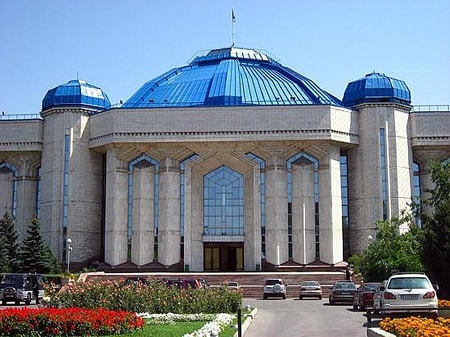
Petya Andreeva
PhD Student of East Asian Languages and Civilizations, University of Pennsylvania
When did you first develop an interest in Slavic, East European and Eurasian Studies?
While pursuing my undergraduate degree at Colby College, I learned the significance of a truly “liberal arts” educational experience, which allows students to explore their potential and interests in various fields of study and develop skills in multiple walks of life. While my primary major at Colby College was East Asian Studies with a focus on China, where I also lived and studied as an exchange student, I was always interested in the concept of cultural transfer or the resistance to such among various polities in Asia. As an international student from Bulgaria, I had had a long exposure to Eastern European culture and had studied Russian in my home country. I remember vividly the day when my extremely supportive undergraduate advisor, Dr. Ankeney Weitz, mentioned to me the possibility of using my Russian and Chinese language skills for larger research projects. She had me look at Russian translations of Western Xia (Tangut) manuscripts, excavated by Russian archaeologists in Khara-Khoto and now kept at the Institute for Oriental Studies in St. Petersburg. I also utilized both my Russian and Chinese language skills to explore topics on to the relationship between image and text in propaganda posters. Looking back, I am convinced that it is my background coupled with my interests in Chinese and Central Asian art that prompted me to pursue a PhD degree at the University of Pennsylvania. At the East Asian Languages and Civilizations Department at Penn, I have had the incredible privilege to encounter outstanding faculty, such as my own advisor Dr. Nancy Steinhardt. What really sparked my interest in Eurasian studies and was perhaps the turning point in my academic career, was a paper which I wrote for Dr. Steinhardt during my first year as a graduate student at Penn. She introduced to me the fascinating topic of Scythian gold and encouraged me to write a paper revisiting the conventional historiographies and filing the gaps in extant scholarship regarding the subject. From then on, my advisor has given me tremendous support and encouragement in my decision to pursue Central Eurasia/ Northern China as my primary region of study. I must say that there must have been a certain degree of serendipity in my decision to come study here, as our department is one of the few East Asian Studies Departments with such a strong expertise on Eurasian studies. To cut a long story short, I have to thank my extraordinary professors both at Colby College and University of Pennsylvania for their dedication to my development as a scholar and for giving me the immense intellectual freedom which guided my academic journey towards Eurasia.
How have your interests changed since then?
My recent decision to pursue a dissertation topic on the so-called “animal style”, alternatively known as “animal art” of the Eurasian steppes was also inspired by several classes which I took with Dr. Paul Goldin, an expert on Early China. Prof. Goldin’s guidance was invaluable in my decision to research recent Chinese and Russian excavations of Bronze and Iron Age nomadic groups, notably the myriad finds of metalwork with zoomorphic motifs in the Ordos Loop, Tuva basin and the region west of Lake Baikal, many of which have not been widely discussed in Western scholarship. It was these classes coupled with my recent work with renowned names in the field of Central Asian Studies, Dr. Christopher Atwood and Dr. Victor Mair, that have inspired my passion for the cultural heritage of the early nomads who were once active along the Chinese northern periphery and further west, all the way to the Crimean Peninsula. I am currently examining the material culture of different Iron Age nomadic groups such as Scythians, Sarmations and Xiongnu as independent yet highly dynamic cultural entities with their unique artistic traces. However, I am also looking at possible interactions between these mobile groups and sedentary populations such as the Greek colonies on the Northern Black Sea Coast as well as the Zhou and Han dynasties in China.
What research project are you pursuing with the Dissertation Grant?
The art associated with the hunting and herding peoples who were once active across the Eurasian steppes come from tombs dispersed across a large geographic domain. The area in which the archaeological sites in question are located incorporates the following geographic regions: Middle Yellow River (Ordos loop), the Eastern Mongolian steppes, Western Mongolian and Tuva basin, the mountainous region west of Lake Baikal, the Northern Tarim Basin, the Kazakh Uplands and the Pontic Steppes of the Northern Black Sea region. My current project aims to 
What do you value about your ASEEES membership?
First, I would like to use this opportunity to express my extended gratitude for the generous dissertation grant which I received from ASEEES. It truly made my fieldwork possible. I value the fact that I am able to read more on the recent trends in Slavic and East European Studies in Slavic Review as well as learn about excellent career opportunities through your website. I also appreciate the opportunity to be able to connect with scholars in the field: having my “base” in East Asian Studies, it is sometimes challenging to forge connections with scholars outside my immediate field, and having ASEEES membership is essential to my academic development.
Besides your professional work, what other interests and/or hobbies do you enjoy?
When I am not working, I enjoy watching documentaries, trying out new adventurous foods and spending quality time with friends and family.